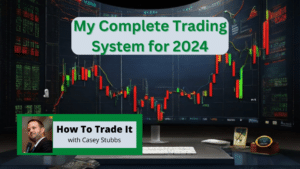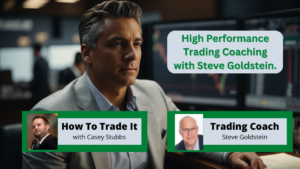How to Sell Covered Calls with Dr. Alan Ellman, Ep #63
Dr. Alan Ellman started trading options in the 1990s. He began with buying and selling stock. When reading an article about IRAs, he learned some allowed you to trade options. He had always heard that options were risky. But he decided to look into it, and covered calls attracted his attention. He taught himself that strategy and the rest is history. Now, Alan is the President of The Blue Collar Investor Corp. His goal is to teach other traders how to sell options the right way. He talks about his covered call strategy in this episode of How To Trade It!
@thebcinvestor shares his strategy for selling covered calls in this episode of How To Trade It. Don’t miss it! #stocks #stock #trading #StockMarket #Investing #DayTrading #StockPicks #Options #OptionsTrading #CoveredCalls Click To TweetSubscribe to How To Trade It
[maxbutton id=”3″][maxbutton id=”4″][maxbutton id=”5″][maxbutton id=”6″]
You’ll want to hear this episode if you are interested in…
- [1:18] How Alan got started in options trading
- [2:11] Controlling the risk levels in options trading
- [4:58] How to sell options to make money
- [10:33] The mid-contract unwind exit strategy
- [12:31] How you’d lose money on the stock side
- [14:52] The three required skills for option selling
- [17:21] How Alan screens for stock + options selection
- [28:15] What to do if the stock price keeps dropping
- [31:25] Two factors Alan uses to decide when to sell the stock
- [32:36] How Alan’s strategy works in a bear market
- [36:50] How to learn more about Alan’s strategies
Alan’s covered call options trading strategy
Alan prefers to be on the sales side of options. He is the casino—not the person at the slot machine. He starts his trades by getting paid for undertaking the option obligation. When you’re doing covered call writing, you’re buying a stock then you’re selling the call option agreeing to sell your shares at a certain price (the strike price) by a certain date (the expiration date). You are in a better position because your break-even is lower than if you had just purchased the stock itself.
If you bought a stock at $48 a share, you could sell a $50 call option for $1.50 per stock (one options’ contract is usually for $100 shares). You get paid $150 the second you execute that trade. However, you do have a contractual obligation to sell your shares at $50 at any time over that contact. Alan prefers one-month contracts that expire on the third calendar Friday of every month at 4 pm Eastern. So you start with a break-even of $48 minus the $1.50 for the option, so the break-even is $46.50. Someone who bought the stock at $48 and didn’t sell an option still has a break-even of $48. Alan emphasizes that anyone who writes covered calls should consistently beat the market because you’re lowering your cost base.
How selling options works to make money
If you bought $100 shares at $48, you have $150 generated into your account instantly. If the price of the stock doesn’t change at all, that’s a 3% return. If the price goes up to $50, you participate in the share appreciation. So you’d make $200 in profit for a total of $350. That’s a 7% one-month return. If the price of the stock goes to $55, you don’t get to participate in the additional $5 after the strike price. But you’re still not losing money. You’ve still made the $350 from the rise in the strike price.
If the price of the stock goes down to $47, you lose $1 on the stock side. But you still have a realized gain of $150 on the options side. It’s still a net gain of $50 on the contract. If you go below $46.50, then you start losing money. But if you’re an experienced covered call writer like Alan, you’ll have an exit strategy plan in place.
If the price is over $50 at expiration, your shares will be sold at the strike price. You don’t have to do anything, your shares will be sold automatically on the Saturday after the expiration. If you don’t want to sell your shares, all you have to do is buy back the option before your covered-call expires. If you buy back the call at $55, you’re probably paying around $5.05 per share, and you are losing money. However, you’re gaining back share value while only losing $0.05 of time value.
What is Alan’s mid-contract unwind exit strategy? Listen to learn more!
How can you sell options to make money? @thebcinvestor shares how he makes it in this episode of How to Trade It! #stocks #stock #trading #StockMarket #Investing #DayTrading #StockPicks #Options #OptionsTrading #CoveredCalls Click To Tweet*Special offer available ONLY for listeners of the How to Trade it Podcast*
Do you have a financial plan for the future? Investing in stocks may be the answer you are looking for. Dream Trades Monthly Alerts makes it super easy for beginners and removes the guesswork by providing you with a monthly in-depth analysis of a high-profile stock. In the last year, Dream Trades has gotten a 100% return on investment for everyone following the reports. Because you are a listener of the How to Trade It podcast, we are giving you a code for $25 off of a one-year subscription. Check it out at DreamTrades.com (click on “monthly alerts” and use the coupon code: podcast, to get $25 off).
How you’d lose money on the flipside
What if you’re up $150 on the options side but you’re down $150 on the stock side (though it’s unrealized because you haven’t sold the shares)? If you’re looking at the trade in its totality, you’re at a breakeven price point. If the stock is good, you could sell another call at another time to make some gains or just wait for the stock price to go back up. You can’t ignore the stock side of the trade. If you’re selling $150 a month in options but losing $300 a month on the stock, you’re losing money.
Because of this, Alan believes there are three very important skills you must master to become a successful options trader:
- Stock selection
- Options selection
- Position management/exit strategy
Most might be good at one or two of these skillsets but very few are good at all three when they’re just getting started. You have to master all three. Listen to learn more about each.
How Alan screens for stock + options selection
Alan has a three-pronged approach to stock selection. These are the very securities that institutional investors love. They love fundamentally sound companies, so you should too. Once Alan has a watch-list of elite-performing securities, then he does technical analysis. He looks for trend and momentum and measures it against volume.
After having gone through the fundamental analysis, he looks at some common sense principles (minimum average trading volume, diversification, asset allocation). That’s step #1 of stock selection. Don’t select the stock that’s giving you the highest premium return. The volatility is directly related to the premium you receive. The more premium, the greater the risk. You have to know your risk tolerance first.
How does Alan choose what type of option to buy? What does Alan look to generate per month? What do you do if the stock price continues to go down? Listen to the whole episode to learn more about Alan’s process!
How does @thebcinvestor screen for the best stock + options? He shares some tips in this episode of How To Trade It! #stocks #stock #trading #StockMarket #Investing #DayTrading #StockPicks #Options #OptionsTrading #CoveredCalls Click To TweetResources & People Mentioned
- Get access to Alan’s eight-part video tutorial: https://www.thebluecollarinvestor.com/bci-beginners-corner/
Connect with Dr. Alan Ellman
- The Blue Collar Investor: https://www.thebluecollarinvestor.com/
- Follow on Twitter: https://twitter.com/thebcinvestor
- Connect on LinkedIn: https://www.linkedin.com/company/the-blue-collar-investor
- Watch on YouTube: https://www.youtube.com/channel/UCRoCa2LnmLO3o8tF6Q2ddvQ
Connect With Casey Stubbs
- Website: https://caseystubbs.com
- YouTube: https://www.youtube.com/TradingStrategyGuides
- YouTube: https://www.youtube.com/caseystubbs
- Twitter: https://www.twitter.com/caseystubbs
- Facebook: https://www.facebook.com/TradingStrategyGuides
- LinkedIn: https://www.linkedin.com/in/caseystubbs/
Subscribe to How To Trade It
Disclaimer: Trading carries a high level of risk, and may not be suitable for all investors. Before deciding to invest you should carefully consider your investment objectives, level of experience, and risk appetite. The possibility exists that you could sustain a loss of some or all of your initial investment. Therefore you should not invest money that you cannot afford to lose. You should be aware of all the risks associated with foreign exchange trading, and seek advice from an independent financial advisor if you have any doubts.









I really enjoyed Dr Ellmans podcast. I paid special attention to the exit plan and the thinking behind it. It makes a lot of sense
Thanks We love this one as well he shared great insight.